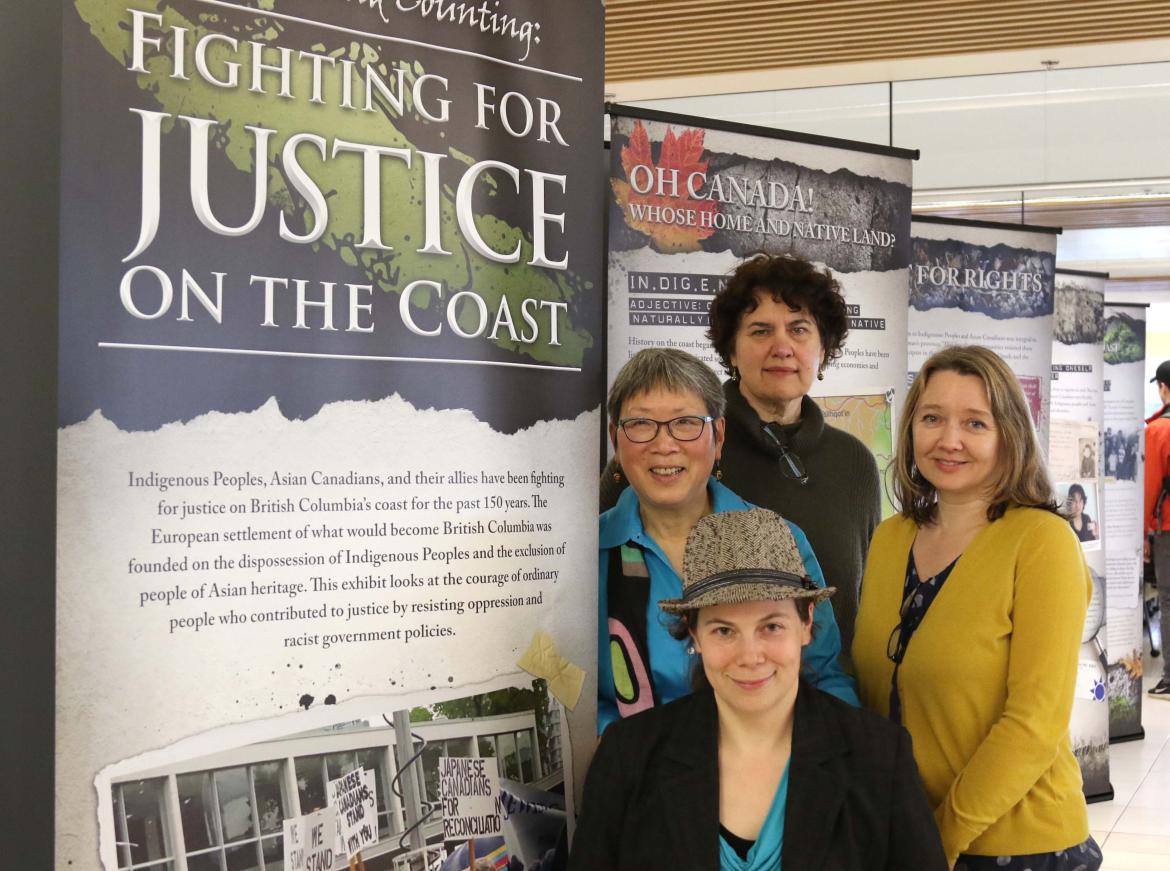
VIU alum Connie Graham, front; VIU Anthropology Professor Dr. Imogene Lim, left; Kathryn Gagnon, Curator/Manager of the Cowichan Valley Museum & Archives, back; and Dr. Tusa Shea, Coordinator of the Arts and Science Programs for the UVic’s Division of Continuing Studies helped create the Fighting for Justice travelling exhibit.
January 26, 2018 - 10:15am
Travelling display a collaborative effort between VIU, UVic and community partners
Wing Hay Young, a popular Port Alberni-born boxer, decided to enlist in the Canadian Army in 1940 during the Second World War.
He was denied entry based on his ethnicity, prompting his white boxing friends to descend on the enlistment office, refusing to sign up until their friend was accepted. Young, who became one of the first Asian Canadians to enlist, went on to distinguish himself on the battlefield.
For many years, Debra Toporowski could not be a member of the Cowichan Tribes because her mother had married a Chinese Canadian man. Under the Indian Act of 1876, women were forced to give up their status if they married a non-Indigenous person. Today, Toporowski is not only a member of Cowichan Tribes, she is a band councillor. Bill C-31, passed in 1985, amended the Indian Act to prevent this gender-based discrimination following pressure by First Nations women on the government.
Both stories are part of 150 Years and Counting: Fighting for Justice on the Coast, a travelling banner exhibit developed by Vancouver Island University (VIU), University of Victoria (UVic), and the Cowichan Valley Museum & Archives. The exhibit is one outcome of the project, Asian Canadians on Vancouver Island: Race, Indigeneity and the Transpacific, led by UVic and funded by the Social Sciences and Humanities Research Council.
It was on display in the library at VIU’s Nanaimo Campus until Friday, January 26, and will be displayed at the Cowichan Campus from Monday, January 29 to mid-February. It returns to the Nanaimo Campus library on February 20 until March 5, at which time people can view it at the Campbell River Museum.
Fighting for Justice personalizes more than 150 years of history from the perspective of First Nations communities, Asian Canadians and their allies, who fought for justice in the face of colonial dispossession and racist exclusions.
“The point of this exhibit is to tell those stories that haven’t been told and showcase the intersections of these communities,” says Dr. Imogene Lim, a VIU Anthropology Professor, who worked on the exhibit’s concept development alongside Dr. Tusa Shea, Program Coordinator, Arts and Sciences Programs for UVic’s Division of Continuing Studies, and Kathryn Gagnon, Curator and Manager of the Cowichan Valley Museum & Archives.
The exhibit tells the history through individual stories of Asian Canadians and First Nations on Vancouver Island, and highlights the ties between different groups on the Island. There are several examples of Asian Canadian and Indigenous communities working together, including an Alert Bay grocery store owned by an Asian Canadian family that continued to provide supplies for potlatches in the area after the government ban.
“I’m hoping people gain an awareness of how resilient these communities were and are, how they fought to preserve aspects of their culture that were under threat,” says Shea.
The key point for Gagnon was telling the stories in simple, bite-sized chunks to give people an idea of the history without overwhelming them – and then encouraging them to pursue more information.
“You have to know it happened before you can explore it,” she says.
One VIU student and one VIU alum also had the chance to work on the exhibit. Anthropology student Chantelle Spicer worked on the accompanying resource guide while Connie Graham, an Anthropology and First Nations Studies graduate, coordinated the exhibit and edited the banner text.
Graham’s favourite part about the exhibit is the emphasis on the diversity of people settling on the Island.
“People have this idea that Canada was colonized by white Europeans and that’s not necessarily the case,” she says. “There was a lot more diversity in the makeup of the original settlers, but they all weren’t treated equally.”
To learn more or book the exhibit, email Dr. John Price, UVic History Professor, at joprice@uvic.ca. To learn more about VIU’s Anthropology program, visit the program homepage.
-30-
MEDIA CONTACT:
Jenn McGarrigle, Communications Officer, Vancouver Island University
P: 250.740.6559 | C: 250.619.6860 | E: Jenn.McGarrigle@viu.ca | T: @VIUNews
Tags: Alumni | Social Sciences | In the Community






